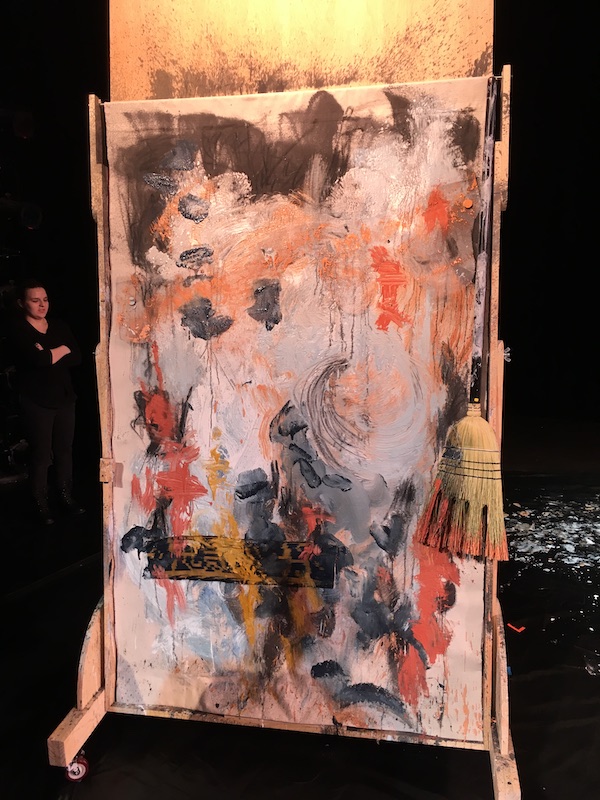Artistic genres converge as Musiqa blends sight and sound

At Musiqa’s concert Saturday night, artist Geraldina Interiano Wise painted this work in real time with the performance of Annie Gosfield’s “The Blue Horse Walks on the Horizon.” Photo: Steven Brown
Visual images, either natural or artistic, have long inspired composers to create musical works.
Houston’s Musiqa returned the favor on Saturday night. As the finale of its concert at the Midtown Arts & Theater Center Houston, the new-music series brought a visual artist onstage to create a painting in response to Annie Gosfield’s string quartet The Blue Horse Walks on the Horizon.
The title certainly conjures up an image in the mind’s eye. But the quartet has nothing to do with that. The New York composer’s program note explains that the title is a translation of “Le cheval bleu se promène sur l’horizon,” a surreal code phrase broadcast by radio to French Resistance fighters during World War II.
The phrase’s spoken rhythm is one of the driving forces of Gosfield’s quartet. The work draws on another wartime source–printed silk fabric that carried messages for the Danish Resistance–for some of its melodies. Prime among those is a jagged five-note motif that makes a quick upward push, then plunges down. Another fragment bears a resemblance to the D-S-C-H motif that Dmitri Shostakovich worked into some of his most dramatic works.
Gosfield weaves all these disparate elements into a 15-minute work that evokes not only the tension and agitation of wartime, but moments of respite amid the turbulence. Sometimes a line of just two or three notes, set against a quiet background, is enough to suggest gentle lyricism. One passage is more buoyant, as if the resistance fighters have allowed themselves to relax and dance a bit.
Musiqa’s quartet–violinists Jackson Guillen and Natalie Lin, violist Sergein Yap, and cellist Barrett Sills—brought fine color and commitment to Gosfield’s score. The group captured the force of the music’s angular lines, the tension and explosiveness of its chords, and the fleeting repose of its hints of melody.
Meanwhile, simultaneous with the performance, Houston artist Geraldina Interiano Wise worked behind an easel. Though the canvas was turned away from the audience, its eight-foot height suggested that Wise was operating on a large format. So did the fact that she painted not with brushes, but with sponges and even a broom, reaching out often to dab them into in pans of paint resting between her and the musicians. Wise sometimes painted so energetically that her jabs at the canvas thumped in sync with the music.
After Gosfield’s tone poem ended, Wise turned the easel around to reveal an abstract expressionist work whose bold daubs of color and billowing masses of black, white and grey evoked the blasts and smoke of wartime explosions. A piece of fabric Wise had pulled from her skirt and attached to the canvas paid homage to those Danish silk pieces. A broom she had used to create the painting was also attached, serving perhaps as her signature.
Saturday’s concert also yielded the premiere of Six Bagatelles, a piano trio by Karim Al-Zand, one of the Houston composers who co-founded Musiqa. Al-Zand, who teaches composition at Rice University, took a print by American artist Robert Motherwell as the inspiration for each of his vignettes.
Before violinist Lin, cellist Sills and pianist Wesley Ducote played each bagatelle, the Motherwell image that spawned it flashed onto a screen behind them. That certainly helped set the scene, but more importantly, the vignettes–each titled after the corresponding print–created tone-pictures of their own. And the musicians brought out their vigor, transparency, richness and songfulness by turns.
“Gauloises Bleues,” a tribute to the iconic French cigarettes, had a jauntiness that suggested Parisian boulevards and cafes. “Yellow Chord” unfolded over a single harmony. But the piano’s sonorities kept evolving, and the violin and cello’s long-breathed lyricism rose in intensity, so the music never seemed static.
“Black Elegy Returning Black (Nocturne)” set its evocative scene by emphasizing the piano’s and violin’s deeper ranges, as the violin and cello sang out a melody that harkened back to Frederic Chopin’s Nocturne in C-sharp minor, Op. 27, no. 1.
An Henri Matisse painting of an artist’s studio lies behind Stephen Hartke’s The Blue Studio for piano trio. The music evokes Hartke’s own workroom, his program note explains, and it sometimes tips a hat to earlier works of his.
While only Hartke aficionados could have picked out those allusions, the trio’s introduction and four vignettes opened Saturday’s program with vitality, introspection and lilt. Violinist Guillen’s intonation sometimes veered off track amid his part’s harmonics and double stops, but he, Sills and Ducote by and large put across each scene’s atmosphere.
Loren Loiacono’s program note for Waxing Cerulean doesn’t explain what that shade of blue has to do with her string quartet. Be that as it may, the work has a certain kinship with Gosfield’s quartet: A rhythmic motif helps drive The Blue Horse, and a rhythm pattern likewise unifies Loiacono’s 10-minute work as it shifts tone and mood.
Guillen, Lin, Yap and Sills captured the music’s boldness and buoyancy, from its stark chords and chattering energy to its flights of melody and impish glissandos. All that gave the group a good warmup for the dramatics of The Blue Horse.


